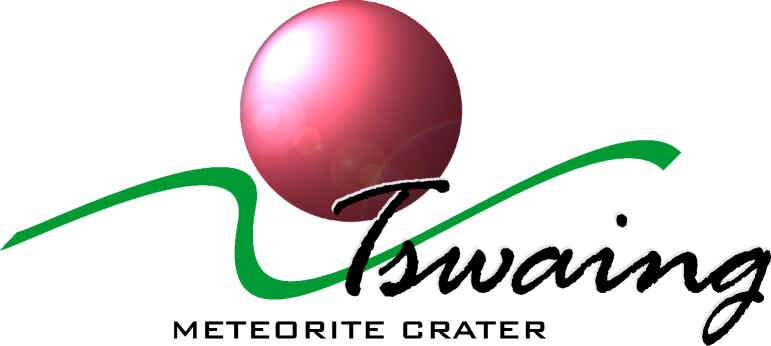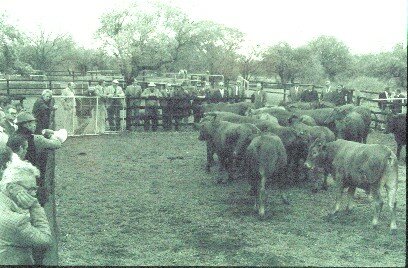|
Farmer's Day at Zoutpan Experimental Farm, 1970's (courtesy National Cultural History Museum) |
 |
|
Agricultural Research |
|
| Home | Tswaing is situated in an ecological region known as the Sourish-Mixed Bushveld. For many years this ecological system had a bad reputation for its low agricultural potential, mainly due to the great variation in the palatability of grass types and the occurrence of toxic plants. The result was that areas with more palatable grasses and less toxic plants were inevitably overgrazed. Overgrazing and the elimination of the tastier grass types increased the occurrence of sourer and less palatable grasses. Another cause of the problem was the extensive use of veld burning in an effort to maintain the growth of tasty grasses and control bush encroachment. Burning the veld, however, often had the opposite effect, as many of the grass types that survived, were the tougher, sourer and less palatable types. Ways of improving farming in the Sourish-Mixed Bushveld had to be found as more optimal use of this region, and other marginal farming areas, in South Africa became more important to increase the production of food and fibre for the country's growing population. Cattle-farming seemed the best option for the agricultural use of the Sourish-Mixed Bushveld, but no research on the best cattle-farming methods had been done yet. A suitable farm in this environment had to be found first in order to undertake such research. Similar research for other ecological regions was already taking place at other agricultural research farms elsewhere in the country. Research results from such farms were normally applied in practice on commercial farms. In 1953 the national Department of Agriculture acquired grazing and other land-use rights of the largest part of the farm Zoutpan (the original farm on which part of Tswaing is situated). The rest remained reserved for soda and salt mining. During the first couple of years Zoutpan was used only to graze the cattle owned by the Department, while the farm was being prepared for research work. In 1954-1956, a number of grazing camps were established (determined by the prevalent types of grass), boreholes for water supply were drilled, drinking ponds were constructed, a cattle herd was assembled and staff were appointed. In 1958 the first research programme got under way. By allowing uncontrolled grazing through large numbers of cattle on Zoutpan, it was proven that the grass became sourer due to overgrazing. During this process the tastier grass types disappeared because they were always eaten first, thereby leaving the sourer and less palatable types thrive. The lack of good quality grass with a high nutritional value in turn led to deterioration in the condition of the cattle with negative effects on breeding. In the mid-1960s a start was made to solve this problem by introducing a new system of controlled selective grazing on Zoutpan, later known as the Zoutpan System, whereby a farm was subdivided into various grazing camps according to the presence of different soil types that determined the growth of grass species. The cattle herd is rotated among these camps for periodic grazing, long enough to force them to graze both palatable and less palatable grass types, and short enough to leave sufficient grass shoots behind to ensure regrowth. At Zoutpan the system also proved that, as a farming method, it could help re-establish an area's natural vegetation. By the early 1970s, in conjunction with a successful cattle-breeding programme, the new system began showing excellent results. Whereas only 56% of the cows produced calves before the system was introduced, this had risen to an average of 87% in 1971. Another indication of the success of the Zoutpan System was the increase in live mass of cattle from 17,9 kg of beef per hectare in 1969 to 30,5 kg of beef per hectare in 1976, demonstrating that the cattle were doing well as a result of the grazing system and breeding programme. An increasing number of officials, students, farmers, school children and international visitors began visiting Zoutpan to learn more about its successes. Zoutpan also became a popular venue for short courses, tours, lectures, demonstrations and information sessions for farmers. In 1978, when it had become clear that the Zoutpan System of cattle-farming in the Sourish-Mixed Bushveld was feasible, a new research programme was started, aimed at finding ways of producing beef oxen that could be marketed at an age of 30 months. After operating for 39 years since its inception in 1953, the Zoutpan Experimental Farm was closed down in 1992 for various reasons, including the conclusion of research projects, lack of funding for new projects, the transfer of research functions from the Department of Agriculture to the new Agricultural Research Council, and increasing pressures from the surrounding communities. |
| Vision | |
| What Is Tswaing? | |
| Geology & Minerals | |
| The Crater Lake | |
| The Controversy | |
| Drilling The Crater | |
| Palaeoclimatic Record | |
| Solving the Riddle | |
| The Meteorite | |
| Witnesses Of The Impact | |
| The Catastrophe | |
| Messengers From Space | |
| People At Tswaing | |
| Salt And Soda Mining | |
| Heritage Site | |
| Short Bibliography | |
| Hours & Tariffs | |
| The Experience | |
| Rules & Regulations | |
| Contact Information | |
| Tips For Visitors | |
| Map & Directions | |
| Links | |
| Crater Chat | |
| (Source: REIMOLD, W U, BRANDT, D, DE JONG, R C, HANCOX, J, 1999, Tswaing Meteorite Crater. An introduction to the natural and cultural history of the Tswaing region including a description of the hiking trail. Popular Geoscience Series 1. Pretoria: Council for Geoscience. Available at the Council for Geoscience, Pretoria, South Africa) | |
|
All intellectual property rights, including but not limited to copyright and trademarks, vested in the material contained on the NFI website is held by the NFI and may not be copied, reproduced, adapted, published or distributed in any form whatsoever without the prior written consent of the responsible person at the NFI. |
|
